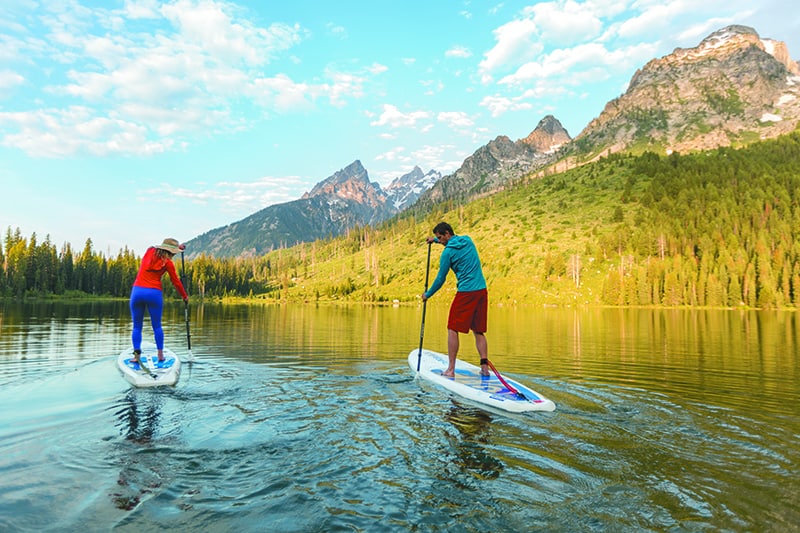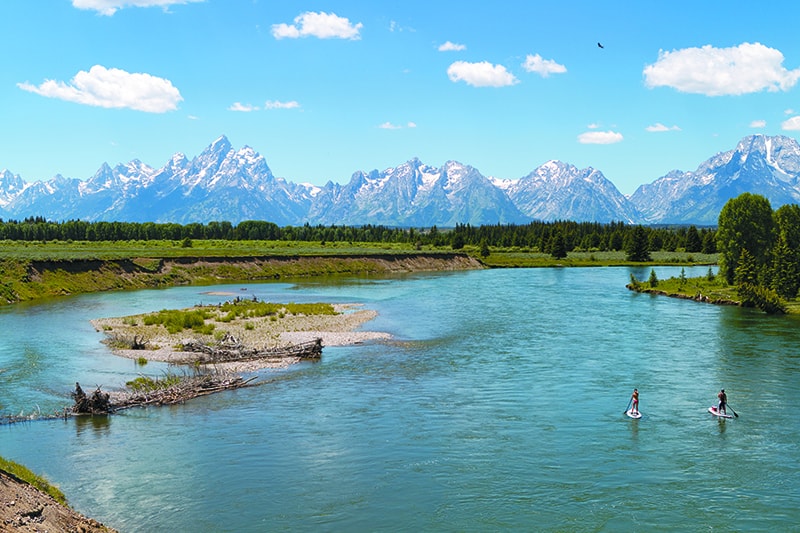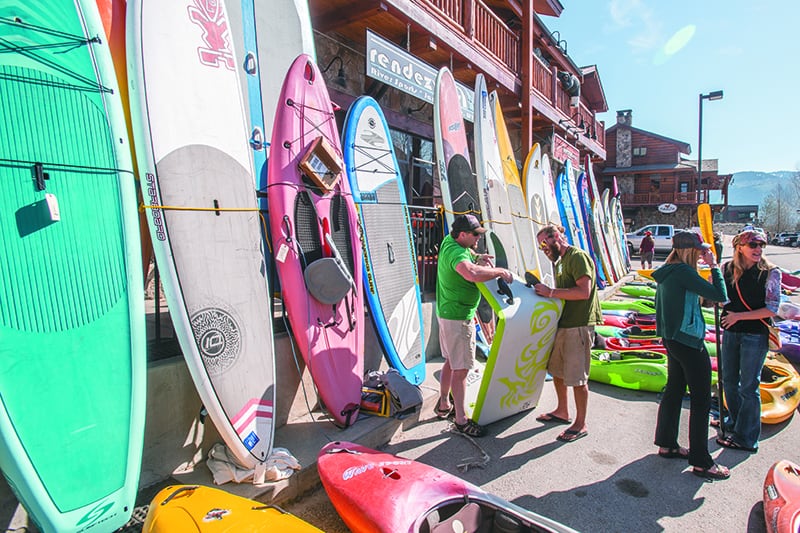Read The
Current Issue
Paddle Power
Stand-up paddleboarding is as easy to learn as it is fun, and you can do it on the Snake River and on lakes around the valley.
By Geraldine Stal

Caryn Flanagan enjoys a sunrise SUP on Jenny Lake in Grand Teton National Park. Photo by Greg Von Doersten
ARRIVING AT THE Jenny Lake boat launch on the lake’s southeastern shore a little before sunrise, mine is the only car. I quickly unfasten the inflatable stand-up paddleboard (SUP, pronounced to rhyme with “cup”) on the roof and carry it and my paddle down to a small beach at the lakeshore. The water is glass. I set the board’s nose on the beach and swing its backend around so the tail fin is in just enough water it doesn’t scrape the bottom. Gear deposited, it’s back to the car, where I dress for my sunrise paddle around the lake, which is in Grand Teton National Park (GTNP): water shoes, a hat, gloves, and a lightweight puffy jacket (it’s summer in Jackson, but the air temperature is about 38 degrees). In less than five minutes, I’m walking the 100 feet back to the shore and my board.
This is my third sunrise at Jenny Lake this week. A sunrise SUP across or around this lake has been my thing for the past month or so. Jenny Lake is the single most visited spot in GTNP, but at 6 a.m., I almost always have it to myself. (Although several times I have shared part of its western shore with moose.) Also, at this early hour there is rarely any wind to battle. These sunrise SUPs are relaxing, meditative, and joyous. Except this morning.
SUPing is the fastest-growing outdoor recreational activity in the U.S. The Outdoor Industry Association’s 2018 Participation Report reveals that between 2013 and 2017 participation in the activity grew 66 percent.
Back at the beach I find my board has left without me. It’s 100 feet out in the lake and moving farther away. Quickly. Without thinking—I do have one thought: “How can it be moving so quickly when there’s no wind?”—I wade into the water, which is quickly up to my knees. Another four steps and it’s at my waist, and I’m not yet halfway to the board. Soon enough my feet don’t even touch the bottom. I start swimming. The down feathers in my puffy coat collapse as they sponge up the cold water. After what feels like five minutes (but is likely fifteen seconds), I grab the board and begin the swim back toward shore.
After this, someone who hasn’t SUPed likely would call it a morning and drive back to town, where there are dry clothes and, at Persephone Bakery, a salve of espresso and a chocolate croissant. I change into skinny jeans and a cashmere sweater I had packed for a 10 a.m. meeting and throw on the spare puffy I always keep in the car. SUPing in skinny jeans and a sweater is better than not SUPing at all. The sport is that good.
I’M NOT ALONE in thinking this. SUPing is the fastest-growing outdoor recreational activity in the U.S. The Outdoor Industry Association’s 2018 Participation Report reveals that between 2013 and 2017 participation in the activity grew 66 percent. Aaron Pruzan, who co-founded Rendezvous River Sports with Gregg Goodyear in 1995, says the shop now sells about as many SUPs annually as it does kayaks.
While it is only in the last decade that SUPing has made it into the mainstream, it’s been around in Hawaii—of course—for centuries. What changed? Laird Hamilton. (Hamilton is generally regarded as one of best surfers of all time, if not the greatest.) By 2003, Hamilton was paddle surfing Jaws, the world’s biggest, heaviest wave. In 2006, he did an endurance paddle across the entire chain of the Hawaiian Islands. While Hamilton engages in extreme, intense SUPing, the sport as practiced by most isn’t extreme or intense. “Part of the reason it’s taking off is that it is easy to learn,” Pruzan says. (Other reasons have to do with it being fun and a great workout.)
Rendezvous River Sports offers private SUP lessons and, this summer, has a multiday clinic that will introduce flatwater SUPers to whitewater SUPing. But most people rent SUPs and try it on their own. “You don’t lose any part of the experience doing it that way,” Pruzan says. (But Rendezvous River Sports can arrange for a private guide for you if that’s what you want.)
WHILE I PREFER early mornings on Jenny Lake, you can certainly SUP on it all day, or SUP on another lake in the valley. If you’d like views similar to those from Jenny Lake, but no motorized traffic (and warmer water), try SUPing at String Lake, which is just to the north of Jenny Lake. String Lake is, like its name suggests, long and skinny. Also, it’s rarely deeper than 6 feet. While there are no motorized boats on String Lake, it is still often crowded. This is because it has the warmest water of any lake in Grand Teton National Park and has beachside picnic tables dotting its northern shore. On weekend days, there might be as many as one hundred others swimming from the shore or SUPing around Sting Lake.
Rendezvous River Sports offers private SUP lessons and, this summer, has a multiday clinic that will introduce flatwater SUPers to whitewater SUPing. But most people rent SUPs and try it on their own.
In the Gros Ventre Mountains, on the east side of Jackson Hole, Lower Slide Lake offers an interesting experience: paddling through standing dead trees that date from prior to this lake’s formation, which happened way back in 1925 when there was a massive landslide on the north flank of Sheep Mountain. (Debris from the slide dammed the Gros Ventre River and created both Lower and Upper Slide Lakes.) When the wind blows from the east, Lower Slide Lake allows for a one-way, wind-assisted trip down its length. This requires a car shuttle, but it’s worth it. Drop one car off at the takeout on Taylor Ranch Road and then head for the campground/boat ramp at the lake’s eastern end with a second car and your SUPs. Launch your board from here and enjoy an easy trip down the lake as the wind does most of the work.
While Jenny Lake is my current favorite SUP, two stretches of the Snake River are No. 2 and No. 3: the section from Jackson Lake Dam to Pacific Creek and the section between South Park and Astoria Hot Springs. The former is about 5 miles long, has no rapids, and is in Grand Teton National Park. The latter is south of the town of Jackson, about 9 miles long, and has a couple of Class II waves that can be avoided if you want. Enjoy.
Nuts & Bolts
Rendezvous River Sports, 945 W. Broadway, Jackson, 307/733-2471, jacksonholekayak.com; rentals from $50/day. Teton Village Sports, 3285 W. Village Dr., Teton Village, 307/733-2181, tetonvillagesports.com; rentals from $50/day. Dornan’s Adventure Sports, 10 Moose Lane., Moose, 307/733-2415, dornans.com; rentals from $50. Snow King Mountain Sports, 402 E. Snow King Ave., Jackson, 307/201-5096, snowkingmountain.com; rentals from $40/day.

SUP on String Lake in Grand Teton National Park. Photo by Greg Von Doersten

Stand-up paddleboarding the Snake River between Pacific Creek and Deadman’s Bar in Grand Teton National Park. Photo by Greg Von Doersten

Bargain hunters check out the SUP selection at Rendezvous River Sports’ annual Boat Swap. Photo by Price Chambers




